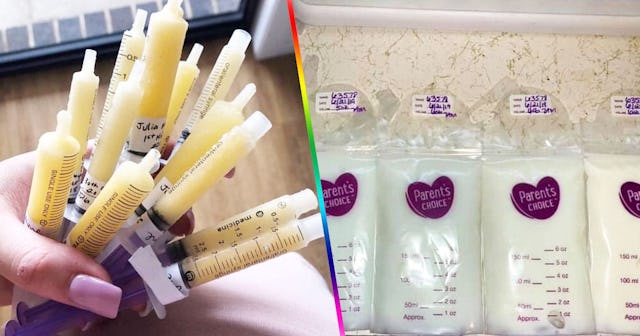What The Color Of Your Breastmilk Can Mean

If you were asked to picture the color of breastmilk, you’d probably imagine a white or yellowish bottle of it. Or maybe you’d imagine its milky white goodness dribbling out of the corner of your baby’s mouth—or, let’s be honest, shooting straight across the room when your baby unlatches.
Either way, it’s probably a whitish color that you’re thinking of, right? Well, the fact is that breastmilk usually is white or yellowish white (liquid gold!), but sometimes breastmilk changes color.
After all, breastmilk is a living tissue made by our amazing bodies. It changes from feeding to feeding, throughout the day and night—and its composition is affected by what we’ve eaten and even what pathogens we have been exposed to.
Pretty incredible, huh?
However, some of these color changes can take us by surprise, especially if they are drastic—for example, if your breastmilk looks bright pink or green. Rest assured, though, in almost all cases, the color change is normal, doesn’t indicate a problem, and in the vast majority of cases, your breastmilk is totally safe for your baby to drink.
Still, it can be concerning when you see these off-the-wall color changes in your milk. So let’s take a look at what they might be—and most importantly, in what rare cases the color change might indicate a problem.
Note: All of this information is courtesy of La Leche League International, unless otherwise indicated.
Yellow Breastmilk
Your baby’s first milk—the milk you produce toward the end of pregnancy and during the first few days after birth, before your mature milk comes in—is called colostrum. This milk, rich in vitamins, protein, and immune factors—often takes on a yellowish or goldish hue.
Breastmilk can turn yellowish or orange based on what you’ve eaten as well. Foods high in carotene (like sweet potatoes and carrots) have been known to turn breastmilk yellow or orange, for example. In addition, frozen milk often takes on a yellowish color.
Watery or Blue Breastmilk
During the beginning of a feed, your milk tends to be thinner, more watery, and sometimes bluish in color (foremilk). As the feed progresses, your milk turns thicker, whiter, or golden (hindmilk). When you pump, you might notice that your early milk has a bluish color, which is totally normal. If you’ve pumped for a full feed, you’ll probably see your milk naturally divide itself into foremilk and hindmilk, with that more watery (and sometimes blue) layer on top and the thicker, creamier layer on bottom.
Green Breastmilk
Breastmilk that is greenish in color can sometimes alarm moms because it might look like spoiled milk. The good news is it’s usually perfectly fine. Greenish milk is often caused by something you ate. For example, Gatorade or another sports drink often does this. But consuming large amounts of green veggies, seaweed, or herbs can also turn your breastmilk green.
https://www.instagram.com/p/rLc4EzriLU/
Sometimes you might notice that your baby’s poo is greenish in color. This is usually fine too. If the poo is green and foamy, that might indicate that your baby is getting a lot of foremilk, which is digested quickly. If your baby seems gassy or upset, you might want to consider letting your baby finish one breast before offering the other so that your baby doesn’t overload on foremilk and gets some of that thicker, more tummy-settling hindmilk that comes at the end of the feed.
Pink or Red Breastmilk
Pink breastmilk is probably the variation that worries moms the most, which makes sense. Again, though, it’s rarely something to be very concerned about. Much of the time time, pink-tinged breastmilk comes from a food dye that you consumed, perhaps a soda, gelatin-containing food, or fruit drink.
Another common culprit is blood from a bleeding nipple, which may have happened because of a latching issue or a baby who bit you (ouch!). Breast infections like mastitis can also cause a small amount of blood in the milk. It’s safe for your baby to drink this milk, and they usually don’t complain of any taste changes.
Another somewhat less common cause of pink or red breastmilk is something called “rusty pipe syndrome.” This generally happens within the first few days after birth and is caused by the milk ducts and milk-making cells in your breasts growing and stretching, causing a little blood to leak into your ducts and your milk. Your milk may look reddish or brownish-red. Again, totally harmless to you and your baby.
When To Go To Your Doctor
Generally, color changes to your milk are really and truly not an issue. And the truth is, most of us don’t even notice when our milk changes color unless we are pumping.
However, there is one time that a color change might be of concern. There is bacterium called Serratia marsescens that can turn your breastmilk pink or red. This is not blood in your milk and it’s not caused by a food dye. According to the Infant Risk Center at Texas Tech University, small amounts of Serratia marsescens in your milk are generally harmless to your baby. But if you have large amounts of it, it could harm your baby.
So basically? If you have pink or red milk and the cause isn’t obvious (for example, your nipples are bleeding), then definitely go to your healthcare provider to get checked. They can test your milk for Serratia marsescens and depending on how serious it is and how vulnerable your baby is, they may ask that you take an antibiotic to clear the infection and pump and dump for a few days.
Of course, if you have any questions whatsoever about the changing colors of your breastmilk, contact your healthcare provider or a lactation consultant. Even though you can be assured that most color changes are totally harmless, always go with your mama instincts if you think something might be amiss.
This article was originally published on